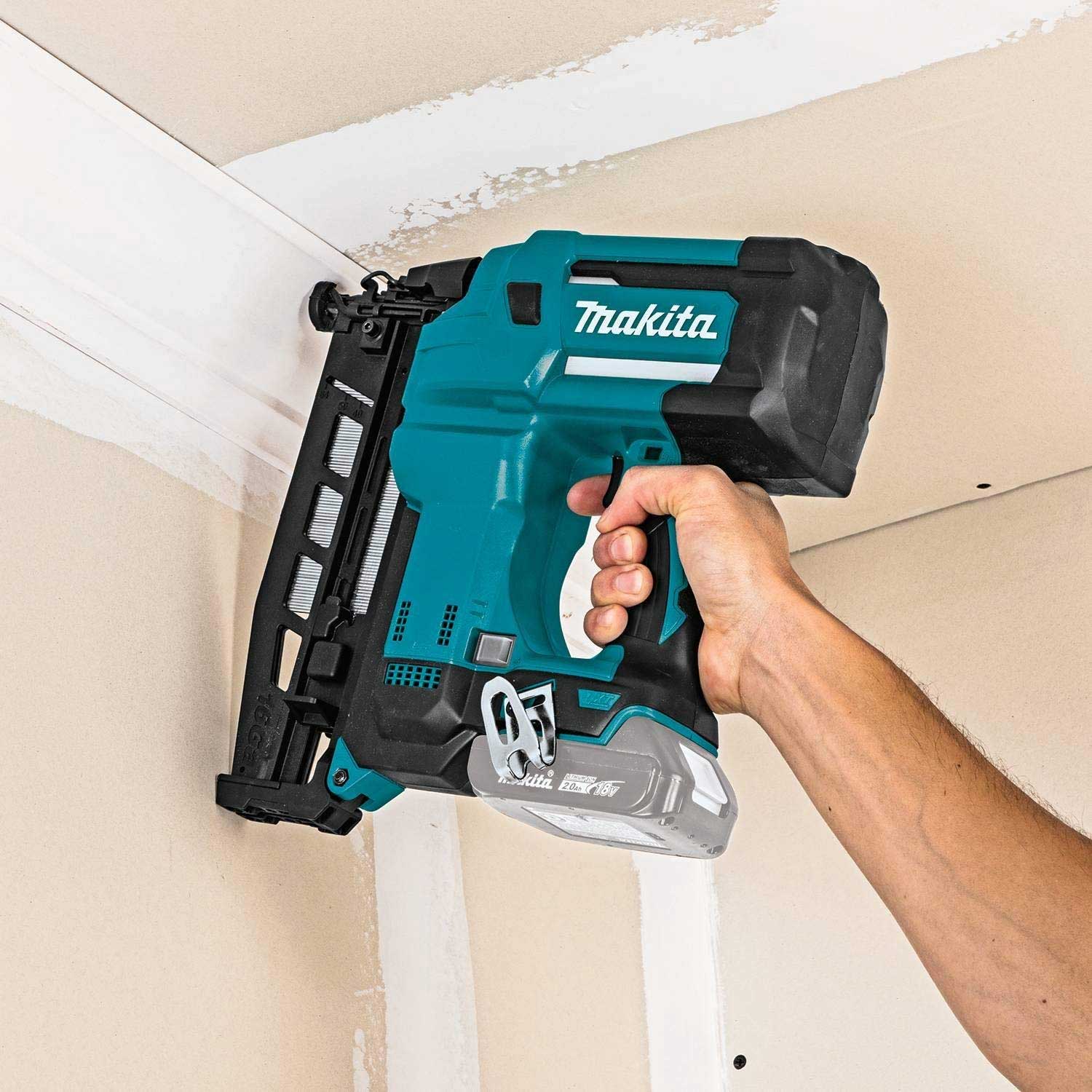Say goodbye to tangled air hoses and the rumble of compressors! Cordless finish nailers empower you to breeze through trim work with quiet power and unparalleled freedom. This guide explores the best battery-powered finish nailers of 2024, breaking down everything from their mechanics to selecting the perfect model for your needs, whether you’re a seasoned pro or a weekend warrior.
Unleashing Cordless Power
Battery finish nailers are revolutionizing woodworking for DIY enthusiasts and professionals. These cordless wonders offer a compelling alternative to traditional pneumatic nailers.
The Cordless Advantage
Imagine installing crown molding high on a ladder. With a pneumatic nailer, you’re wrestling an air hose and possibly a noisy compressor. Now picture the same scenario with a cordless finish nailer. Pure freedom! These tools deliver the precision of their air-powered counterparts without the cord chaos, drawing power from rechargeable lithium-ion batteries (typically 18V or 20V). They’re perfect for driving slender 15 or 16 gauge finish nails, ideal for trim, molding, and delicate work. Discover the incredible warmth and energy efficiency of batt insulation for your home projects. And for bathroom renovations, explore inspiring bathtub tile surround ideas.
18V vs. 20V: Decoding the Voltage
The 20V label often seen is largely a marketing tactic, referring to the peak voltage. Sustained voltage during operation typically settles around 18V. Therefore, 18V and 20V models generally offer comparable power.
Why Go Cordless?
Cordless nailers excel in maneuverability, allowing access to tight spots and awkward angles, eliminating the need for a nearby power outlet. They tend to be quieter than pneumatic nailers, a benefit for your ears and your neighbors. Their lighter weight and simpler operation make them ideal for beginners and experienced users alike.
Finding the Right Nailer
The market offers a wide array of battery finish nailers from brands like DeWalt, Ryobi, Milwaukee, and Paslode. Consider your typical projects. Do you primarily use 15-gauge (slightly heavier tasks) or 16-gauge (finer work) nails? Do you need an angled nailer for tight spots or a straight nailer for better visibility? Look for features like tool-less jam clearing and depth adjustment.
Runtime: A Critical Factor
While voltage gets attention, runtime is paramount. A nailer with a high-capacity battery driving hundreds of nails per charge maximizes productivity. Look for models with extended runtimes or invest in extra batteries. Fuel gauge indicators are a helpful feature.
Ergonomics and Comfort
A comfortable nailer is essential, especially for extended projects. A heavy, unbalanced tool leads to fatigue and potential strain. Choose a nailer with a comfortable grip and manageable weight. Vibration-dampening technology enhances comfort.
Noise Reduction
Noise levels are significant, especially in noise-sensitive environments. Battery finish nailers are inherently quieter than pneumatic models, contributing to a more pleasant work experience.
Real-World Performance
Reviews and specifications only tell part of the story. Seek reviews that test nailers on various wood types and angles to gauge their power, consistency, and overall performance.
Choosing the Right Nailer: At a Glance
| Feature | Description | Why It Matters |
|---|---|---|
| Power Source | 18V or 20V Lithium-ion battery | Determines runtime and power output. Longer runtime minimizes interruptions. |
| Nail Gauge | 15-gauge or 16-gauge finish nails | Choose the right gauge for your project: 16-gauge for finer work, 15-gauge for more robust tasks. |
| Angled vs. Straight | Angled nailers access tight spaces; straight nailers offer better visibility. | Consider your typical working angles. |
| Runtime | Measured in nails per charge or minutes of use. | Crucial for larger projects. Invest in extra batteries for uninterrupted workflow. |
| Ergonomics | Weight, balance, and grip comfort. | Affects comfort and reduces fatigue. |
| Features | Tool-less jam clearing, depth adjustment, dry-fire lockout, etc. | Enhance convenience and usability. Streamline your workflow with helpful features. |
| Price | Varies based on brand, features, and battery capacity. | Find the balance between performance and budget. A higher upfront investment may offer long-term value. |
Where Battery Finish Nailers Excel
From intricate trim to delicate furniture assembly, battery finish nailers are versatile tools for finish carpentry, cabinetry, and DIY projects. They offer precise, cordless fastening, empowering you to tackle any finishing task. Their convenience and portability may even inspire you to take on more ambitious projects.
Weighing the Drawbacks of Battery-Powered Nail Guns
While cordless nailers offer convenience, understanding their limitations is crucial for informed decision-making. Let’s explore potential downsides, from weight and cost to job site performance and future prospects.
Weight: A Literal Burden
Cordless nailers are noticeably heavier than pneumatic nailers due to the battery. While manageable for short tasks, extended use, particularly overhead, can cause fatigue and impact precision. Intricate crown molding installation, for example, becomes challenging with a heavy tool.
Cost: The Price of Convenience
While bypassing the initial air compressor cost, cordless nailers involve the expense of replacement batteries, which can be substantial for frequent users. These costs can accumulate, potentially exceeding a pneumatic setup’s price.
Runtime: The Battery’s Ticking Clock
Cordless nailers have limited runtime. Running out of power mid-project disrupts workflow. Spare batteries are essential, adding to the cost and management hassle. For larger projects, these interruptions hinder productivity.
Power and Performance: Not Always Consistent
While battery technology is improving, power inconsistencies can occur, particularly as the battery drains. This might manifest as nails not sinking fully or firing delays, especially compared to a pneumatic nailer’s instant response. While newer models improve performance, it’s a factor to consider.
Project Suitability: Not Always the Best Choice
Cordless nailers are excellent for smaller tasks, quick fixes, or locations without power access. However, for large-scale projects like framing, their limitations are apparent. Frequent recharging disrupts workflow. Pneumatic nailers offer consistent power and unlimited runtime, proving more efficient for demanding tasks.
Ergonomics: Long-Term Comfort
Beyond weight, a cordless nailer’s bulk can contribute to strain and fatigue during prolonged use, leading to wrist or hand discomfort. These stresses accumulate, potentially causing injuries.
Environmental Impact: Batteries and Sustainability
Battery production and disposal pose environmental concerns. While pneumatic tools also have an environmental footprint (compressor manufacturing, electricity usage), battery life cycle raises sustainability questions. Newer battery technologies aim to address these, but it’s a factor to weigh.
The Future of Cordless Nailers: What Lies Ahead?
Battery technology is rapidly evolving. Higher-capacity batteries with rapid charging times could eliminate current limitations, potentially making cordless the undisputed choice. Pneumatic nailers currently retain advantages for certain tasks. The future holds exciting possibilities for cordless technology.
| Feature | Cordless Nailer | Pneumatic Nailer |
|---|---|---|
| Power Source | Battery | Air Compressor |
| Weight | Heavier | Lighter |
| Initial Cost | Higher | Generally Lower |
| Running Costs | Batteries | Minimal (air) |
| Runtime | Limited | Unlimited |
| Maintenance | Less | More (compressor) |
| Portability | High | Lower |
| Noise Level | Quieter | Louder |
Tool technology is constantly evolving. Today’s drawbacks may be resolved by future innovations. Staying informed about the latest developments is always wise when investing in tools.
Trim Nailer vs. Finish Nailer: Choosing the Right Nail Gun for Your Project
We’ve covered the basics, but now let’s delve into the nuances of trim and finish nailers. Choosing the right tool is like selecting the appropriate footwear – you wouldn’t wear hiking boots to a wedding.
Understanding Nailer Gauges
“Gauge” measures nail thickness. A higher gauge number indicates a thinner nail. An 18-gauge brad is hair-thin, perfect for delicate, nearly invisible fastening. A 15-gauge nail is thicker and stronger, designed for projects requiring a robust hold.
Picking the Right Nailer
Trim Nailers (Brad Nailers): Designed for delicate tasks like attaching thin crown molding or assembling crafts. 18-gauge brads leave tiny holes, easily concealed with filler or paint.
Finish Nailers: Provide greater holding power for tasks like installing baseboards, door frames, or cabinetry. 15- or 16-gauge nails offer secure fastening. While larger than brad nail holes, they’re still easily concealed. Some experts even suggest using a finish nailer with thicker trim like window casings.
The Core Difference: Nail Thickness
The choice boils down to the nail: thin and discreet (trim nailer) or thick and strong (finish nailer). Using the wrong tool can lead to flimsy trim or split delicate pieces.
Features Beyond the Basics
- Angled vs. Straight Magazine: Angled magazines access tight spaces; straight magazines are sometimes easier to load.
- Depth Adjustment: Essential for both nailer types, controlling nail depth prevents damage and ensures secure fastening.
Matching the Nailer to Your Wood
Wood density influences nail size selection. Hardwoods like oak need thicker nails. This chart provides general guidance:
| Wood Type | Recommended Nailer | Nail Gauge |
|---|---|---|
| Pine | Trim or Finish | 18 or 16 |
| Oak | Finish | 15 or 16 |
| Maple | Finish | 16 |
| MDF | Trim or Finish | 18 or 16 |
Power Source Considerations
Cordless nailers provide freedom of movement, while pneumatic nailers offer consistent power. The choice depends on individual preferences and project demands. Ongoing research in battery technology suggests future cordless models may offer even greater power and runtime.
15-Gauge vs 16-Gauge Finish Nailer: The Ultimate Guide to Choosing the Right Tool
Choosing the right finish nailer ensures smoother projects and professional results. Let’s explore the 15-gauge vs. 16-gauge dilemma.
Decoding the Gauge
“Gauge” refers to nail thickness. A lower gauge number means a thicker nail. A 15-gauge nail is thicker than a 16-gauge, impacting the nailer’s strengths.
15-Gauge: The Workhorse
Ideal for thick trim, hardwoods, or outdoor projects, the 15-gauge nailer excels in tasks like installing baseboards or building porch railings. While thicker nails leave larger holes requiring filling and sanding, the rock-solid hold is worth it for heavy-duty jobs.
16-Gauge: The Precision Instrument
Perfect for delicate crown molding, picture frames, or thin paneling, the 16-gauge nailer prioritizes finesse. Smaller nails minimize filling and sanding, making it ideal for detailed woodworking and interior projects. While versatile, it’s not for heavy-duty tasks. It’s best suited for smaller trim and softer woods.
Cordless vs. Pneumatic
Consider power source: cordless for portability, pneumatic for consistent power. The best choice depends on your preferences and work environment.
Wood Type and the Glue Factor
Matching your nailer to the wood is critical. Hardwoods generally require a 15-gauge, while softwoods can often be handled by a 16-gauge. Construction adhesive significantly boosts holding power, sometimes enabling a smaller gauge. Using a 16-gauge with hardwoods and glue can minimize filling and sanding.
Making the Right Choice: A Personalized Approach
There’s no single “best” answer. Consider the wood, trim size, desired finish, glue usage, work location, and importance of cordless convenience vs. pneumatic power.
| Feature | 15-Gauge Nailer | 16-Gauge Nailer |
|---|---|---|
| Holding Power | High – ideal for hardwoods. | Medium – Good for softer woods and lighter trim. |
| Nail Hole Size | Larger – More filling required. | Smaller – Less noticeable, minimal finishing. |
| Ideal Projects | Heavy trim, exterior work. | Fine trim, interior projects. |
| Versatility | Specialized for heavy-duty tasks. | More adaptable for various projects. |
Choosing the right tool elevates woodworking projects. Understanding gauge differences and considering these factors empowers informed decisions and achieves professional-looking results.
- How to Get Motor Oil Out of Clothes: Proven Methods & Step-by-Step Guide - April 25, 2025
- How to Get Mothball Smell Out of Clothes: A Complete Guide - April 25, 2025
- How to Get Highlighter Out of Clothes: Easy & Effective Stain Removal Guide - April 25, 2025










